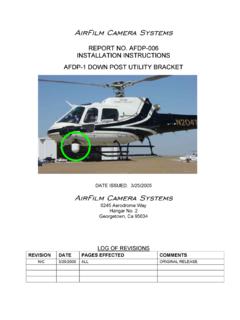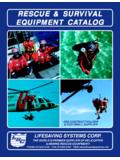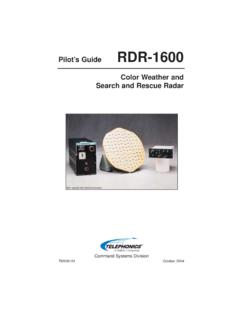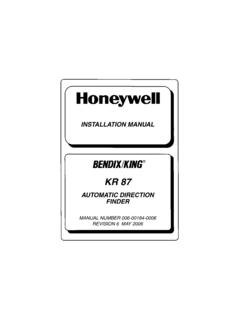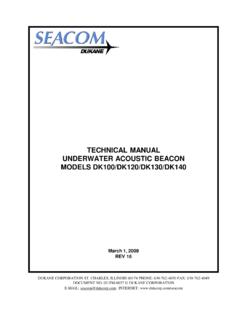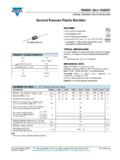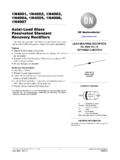Transcription of RDR-1600 WEATHER RADAR SYSTEM INSTALLATION MANUAL
1 RDR- 1600 . WEATHER RADAR SYSTEM . INSTALLATION MANUAL . April 2005. Prepared by: TELEPHONICS CORPORATION. 815 Broad Hollow Road Farmingdale, New York 11735. USA. TM106601 (4/05) Revision 3. COMMAND SYSTEMS DIVISION. RDR- 1600 . WEATHER RADAR SYSTEM . INSTALLATION MANUAL . Copyright 1995/2001 Telephonics Corporation Publication No.: TM106601. All Rights Reserved Printed in Telephonics Corporation, Command Systems Division (CSD). 815 Broad Hollow Road, Farmingdale, New York 11735. Telephone: (877) 517-2327 Fax: (877) 755-7701.
2 This publication may not be reproduced in part or in whole without the expressed written consent of Telephonics Corporation. TM106601 (4/05) Revision 3. COMMAND SYSTEMS DIVISION. CAUTION. Maintain prescribed safe distance when standing in front of radiating antenna. Never expose eyes or any part of the body to an unterminated wave guide. TM106601_(4/05) Revision 3 FMi USE OR DISCLOSURE OF DATA CONTAINED ON THIS PAGE IS SUBJECT TO THE. RESTRICTION ON THE TITLE PAGE OF THIS DOCUMENT. COMMAND SYSTEMS DIVISION. MAXIMUM PERMISSIBLE EXPOSURE LEVEL (MPEL).
3 In order to avoid the envelope in which the radiation level exceeds the Government standard of 1 mW per square centimeter, all personnel should remain beyond the distance indicated in the illustration below. The distance to the MPEL boundary is calculated upon the basis of the largest antenna available with the RDR- 1600 SYSTEM , rated output power of the transmitter and in the non- rotating or boresight position of the antenna. With a scanning beam, the power density at the MPEL. boundary is significantly reduced. FMii TM106601 (4/05) Revision 3.
4 USE OR DISCLOSURE OF DATA CONTAINED ON THIS PAGE IS SUBJECT TO THE. RESTRICTION ON THE TITLE PAGE OF THIS DOCUMENT. COMMAND SYSTEMS DIVISION. INSTALLATION MANUAL . RDR- 1600 WEATHER RADAR SYSTEM . AC 20-68B. DATE 8/8/80. DEPARTMENT OF TRANSPORTATION. Federal Aviation Administration Washington, .. Subject: RECOMMENDED RADIATION SAFETY PRECAUTIONS FOR GROUND OPERATION OF. AIRBORNE WEATHER RADAR . 1. PURPOSE. This circular sets forth recommended radiation safety precautions to be taken by personnel when operating airborne WEATHER RADAR on the ground.
5 2, CANCELLATION. Ac 20-68A, dated April 11, 1975, is canceled. 3. RELATED READING MATERIAL. a. Barnes and Taylor, Radiation Hazards and Protection (London: George Nevnes Limited, 1963). P. 211. b. Department of Health, Education and Welfare, Public Health Service, Consumer Protection and Environmental Health Service, Environmental health microwave, ultraviolet radiation and radiation from lasers and television receivers An Annotated Bibliography, FS : RH-35, Washington, Government Printing Office, pp. 56-57. c. Mumford, , Some technical aspects of microwave radiation hazards, Proceedings of the IRE, Washington, Government Printing Office, February 1961, pp.
6 427-447. 4. BACKGROUND. Dangers from ground operation of airborne WEATHER RADAR include the possibility of human body damage and ignition of combustible materials by radiated energy. Low tolerance parts of the body include the eyes and testes. 5. PRECAUTIONS. Management and supervisory personnel should establish procedures for advising personnel of dangers from operating airborne WEATHER radars on the ground. Precautionary signs should be displayed in affected areas to alert personnel of ground testing. a. GENERAL.
7 (1) Airborne WEATHER RADAR should be operated on the ground only by qualified personnel.. TM106601_(4/05) Revision 3 FMiii USE OR DISCLOSURE OF DATA CONTAINED ON THIS PAGE IS SUBJECT TO THE. RESTRICTION ON THE TITLE PAGE OF THIS DOCUMENT. COMMAND SYSTEMS DIVISION. INSTALLATION MANUAL . RDR- 1600 WEATHER RADAR SYSTEM . AC 20-68B 8/8/80. (2) Installed airborne RADAR should not be operated while the aircraft is in a hangar or other enclosure unless the RADAR transmitter is not operating, or the energy is directed toward an absorption shield which dissipates the radio frequency energy.
8 Otherwise, radiation within the enclosure can be reflected throughout the area. b. Body Damage. To prevent possible human body damage, the following precautions should be taken: (1) Personnel should never stand nearby and in front of a RADAR antenna which is transmitting. When the antenna is not scanning, the danger increases. (2) A recommended safe distance from operating airborne WEATHER radars should be established. A safe distance can be determined by using the equations in Appendix 1 or the graphs of figures 1 and 2.
9 This criterion is now accepted by many industrial organizations and is based on limiting exposure of humans to an average power density not greater than 10 milliwatts per square centimeter. (3) Personnel should be advised to avoid the end of an open waveguide unless the RADAR is turned off. (4) Personnel should be advised to avoid looking into a waveguide, or into the open end of a coaxial connector or line connector to a RADAR transmitter output, as severe eye damage may result. (5) Personnel should be advised that when high power RADAR transmitters are operated out of their protective cases, X-rays may be emitted.
10 Stray X-rays may emanate from the glass envelope type pulser, oscillator, clipper, or rectifier tubes, as well as magnetrons. c. Combustible Materials. To prevent possible fuel ignition, an installed airborne WEATHER RADAR should not be operated while an aircraft is being refueled or defueled. BEARD. Director of Airworthiness FMiv TM106601 (4/05) Revision 3. USE OR DISCLOSURE OF DATA CONTAINED ON THIS PAGE IS SUBJECT TO THE. RESTRICTION ON THE TITLE PAGE OF THIS DOCUMENT. COMMAND SYSTEMS DIVISION. INSTALLATION MANUAL .
